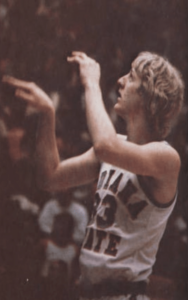Scaling AI Fluency for Marketing Teams: How ASU Leads with Innovation and Intent
See how ASU is leading AI fluency for marketing teams through leadership buy-in, innovation challenges, and custom tools that drive real, campus-wide impact.
Branding
One of the joys of working in enrollment marketing is the chance to promote truly incredible education brands with long and inspirational histories. But how much should colleges and universities lean on legacy branding to recruit new students?
We all know that legacy is a big part of advancement marketing.
Many donors give because they want to see the legacy of the school live on. This, of course, is in large part due to the long view through which people with years of experience tend to see things.
But that definitely is not the profile of your traditional prospective student!
Since your audience doesn’t yet have the advantage of years of experience and long-view thinking, does legacy branding work at all to attract Gen Z (and later Gen Alpha) prospective students?

Despite being a relatively small university compared to their peers, ISU has had an outsized impact on American culture through one very famous alum, the legendary Larry Bird.
Here are some highlights of our conversation, but please check out the podcast episode to hear all of the amazing insights that Jason shared with us!

But ISU’s legacy goes way beyond sports. Jason briefly tells the story of the ISU legacy.
Indiana State University has been around for over 150 years, located on the Indiana-Illinois border in Terre Haute, Indiana.
We started off as a normal school, and it’s expanded quite dramatically since then. But we’re probably most recognizable from a famous alum, and very inspirational Cinderella story within basketball, that alone being Larry Bird.
So we have got a wonderful legacy and athletics, and the university today is just under 10,000 students.
It’s hard to exaggerate the impact Larry Bird’s career has had on the ISU brand.
They are known for their unique focus on teaching, but it was Larry who put them on the map.
Legacy branding makes a lot of sense for alumni marketing where nostalgia is a major attraction.
Especially in sports, nostalgia is an incredibly powerful factor.
Being able to remember the games, the wins, the losses—all of those lived experiences with their fellow alumni.
And of course, advancement departments undoubtedly love promoting the “glory days” to their school alums.
But obviously you won’t be able to lean on legacy branding as much with young prospective students who did not live out those shared experiences with your education brand.
So how much can you lean on legacy branding?
At first, Jason and his team were trying to lean away from it almost all together.
We’ve had a variety of different discussions, studies, decisions made about rebranding the university for the 21st century, what we’re going to look like for the next 20 years.
In some ways, we were moving away from the brand that was more of that legacy, or historic piece of it.
But then Jason had a conversation with some Gen Z students, and his thoughts changed on the subject.
I was teaching a marketing class to some of our juniors and seniors in the College of Business. One of the projects we gave them was to design a set of apparel that they could be proud of and wear to represent the university.
What was really interesting is all of the groups identified with the historic element of the university.
They described it in different ways, and it wasn’t always accurate. But it was some sort of connection to an understanding that there was this really high, national level of prominence that Indiana State was once at.
They’re proud of that. They want to be proud of that.
I would ask questions like, “This happened well before you were born. Do you still connect [with this legacy]?”
And the answer was, “Yes.”
There’s a connection, almost a craving, to recognize the greatness that once existed.
And that was the epiphany for me. Indiana State is fortunate to have this legacy of being successful in the past.
We’re still successful today by many accounts, but at least having this national prominence that most universities of our size don’t have, we have the ability to say that.
We have to wrap our minds around this and not shy away from this [attraction to legacy branding].
[We shouldn’t] just live in those days, but [we should] find a way in which that environment can help us move forward.
For prospective students, it’s not nostalgia, but there is definitely a draw towards a popular trend to all things “retro” or “vintage.”
It creates some kind of powerful emotive connection with younger people when they engage with legacy branding.
At the same time, we can’t live there.
We can’t try to recreate what was done in the past and recreate that environment. I don’t think students want that.
Students are intuitive enough to know when legacy branding has gone too far and is inauthentically trying to live in the past.
Pay homage to the past, but don’t try to take us back there.
To tease out a little more insight into this tension, I asked Jason to explain more of what he learned from his students in their conversation.
I scratched away at [the conversation] a little bit to kind of get a sense of what they were really saying. And the best way I can visually describe the words they were using to describe the emotions [they experienced with legacy branding] is the old 80’s Bronco, or 70’s Ford Bronco.
You don’t know which vehicles are going to be nostalgic and really popular 40 years from now.
Right now, the Bronco is really, really, really popular, and there’s going to be an audience of folks that want that Bronco to look and operate just like it did off the factory line in those days.
But that’s not really what the majority of folks want. That’s not what’s popular today.
There is clearly a brand-new version of the Bronco, which I’m sure is fantastic.
But it doesn’t have the same “cool” factor, that kind of “tough” factor that those old ones did.
What’s popular right now are those Broncos that we would call a “resto-mod.”
[Resto-mods] take the frame, look, and body of what was so cool, vintage, and timeless about [the Bronco], and drop it on something that’s modern, with all the functionality, dependability, and performance that we would want to have in this era.
I think we could look at our marketing campaign in the same way.
We’ve got this really cool, old body style that clearly people are looking back at and going, “Hey, I love the powder blue. I love those [branding] elements that remind me of that Cinderella-type story [of Larry Bird].
But if you step foot on our campus today, it looks completely different.
Almost every square foot of the campus has been renovated and has the most modern and high tech touches.
That’s a great way to take that cool factor from our history and our legacy, and blend it with the modern, unique qualities that were not true back then.
I like the analogy of this current trend of “resto-modding” the Ford Bronco and legacy branding for schools.
It perfectly encapsulates the idea behind blending the strengths of your institution’s past with the promise of the future.
As you tackle the tension between legacy branding and the future, find ways to blend the two branding strategies.
Like all of our blog post reviews of The Higher Ed Marketer podcasts, there’s so much more to learn in the podcasts themselves.
Listen to our interview with Jason Trainer to get even more insights into:
Then you’ve got to know how to write for the web. That’s why we want to send you our popular ebook: Writing for the Web: 7 Secrets to Content Marketing Success for Education Marketers!
With this helpful resource, you’ll learn how to:
In short, you’ll be able to write the copy that makes your digital marketing strategy work for you. Download your copy today!
Featured image via indstate.edu
Larry Bird image via Wikimedia Commons
Subscribe to The Higher Ed Marketer podcast today!